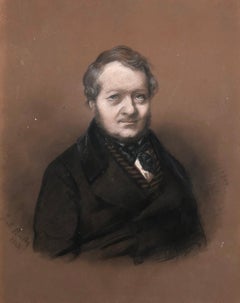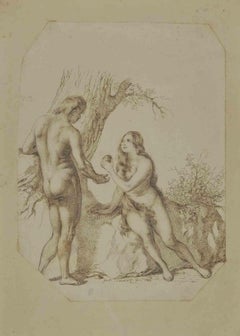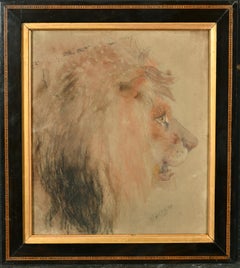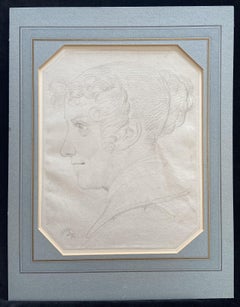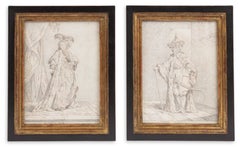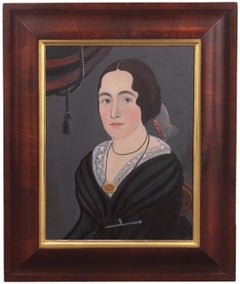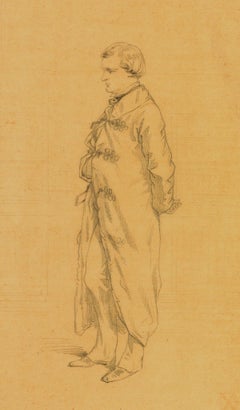1840s Portrait Drawings and Watercolors
to
2
10
1
6
1
9
1
10
1
Overall Height
to
Overall Width
to
1
1
11
9
6
4
4
4
2
1
1
1
1
1
1
90
586
2,249
857
41
62
104
171
152
154
160
206
100
77
74
1
1
1
1
3
3
2
2
2
Period: 1840s
Jules Boilly, Portrait Of A Man, Drawing Dated 1843
Located in SAINT-OUEN-SUR-SEINE, FR
Jules Boilly (1796-1874)
Portrait of a man.
Drawing in black stone and white chalk.
Signed and dated 1843.
Very small dirt and scratches.
Insulated paper.
27 x 21 cm
Category
1840s Portrait Drawings and Watercolors
Materials
Chalk
French Romantic school, Portrait of a young man, drawing
Located in Paris, FR
French Romantic school, circa 1840
Portrait of a young man,
charcoal on paper
22.5 x 17 cm
In good condition, however, there is a restoration of the paper in the upper right-hand qu...
Category
Romantic 1840s Portrait Drawings and Watercolors
Materials
Charcoal
Adam and Eve - Drawing - 1849
Located in Roma, IT
Adam and Eve is a drawing realized in 1849 and attributed to the painter and draughtsman Luigi Sabatelli (1772-1850).
Applied on cardboard: 35 x 25 cm
Hand-signed on the lower and ...
Category
Modern 1840s Portrait Drawings and Watercolors
Materials
Paper
French school circa 1840, Portrait of a Lady, watercolor
Located in Paris, FR
French school circa 1840
Portrait of a Lady
watercolor on Bristol paper
25.5 x 20 cm oval
in quite good condition : slightly yellowed by time, multiple little scratches, stains (see ...
Category
Old Masters 1840s Portrait Drawings and Watercolors
Materials
Watercolor
19th century English chalk drawing on paper of a Lions head
Located in Woodbury, CT
William Huggins was born in Liverpool, England on the 13th of May, 1820. His parents were Samuel and Elisabeth Huggins. He took his first drawing lessons from the Liverpool Mechanics...
Category
Victorian 1840s Portrait Drawings and Watercolors
Materials
Paper, Pastel
Achille Devéria (1800-1857) A young woman seen in profile, original drawing
Located in Paris, FR
Achille Devéria (1800-1857)
A young woman seen in profile
Black Chalk on paper
with cut edges
Bears the stamp of the Achille Deveria Estate Sale of 1...
Category
Romantic 1840s Portrait Drawings and Watercolors
Materials
Carbon Pencil
Miniature portrait of a Gentleman
Located in Lincoln, GB
Miniature portrait of a Gentleman
Early 19th Century, watercolour on paper
c. 1840
Category
1840s Portrait Drawings and Watercolors
Materials
Watercolor
Attributed to Eugène Devéria (1805-1865) La famille heureuse, watercolor
Located in Paris, FR
Attribuetd to Eugène Devéria (1805-1865)
La Famille heureuse (The Happy Family)
Watercolor on paper
23 x 18 cm
In quite good condition : a small tear i...
Category
Romantic 1840s Portrait Drawings and Watercolors
Materials
Watercolor
Denis Auguste Raffet (1804-1860) Studies of a Tiroler Kaiserjäger, drawing
Located in Paris, FR
Denis Auguste Raffet (1804-1860)
Studies of a Tiroler Kaiserjäger,
Signed and dated 1849 lower right
Ink on paper
16.5 x 25.5 cm
In a nice period frame : 33 x 42 cm
Raffet had the occasion to draw studies of austrian soldiers as he took part as observer to the first Italian Independance War (1848-1849). It was the the first of many conflicts between the Kingdom of Sardinia , which later became the Kingdom of Italy , and the Austrian Empire.
The Kaiserjäger (imperial hunters) were founded in 1815 by Emperor Franz I. It was a great honor to enter the Kaiserjäger as they were the only ones to be honored with the term "imperial". However, only Tyrolese, Voralbergers and Welschtirolers were allowed.
They wore this characteristic hat as a parade headdress, it was made of matte black, waterproof felt. It consisted of a crown and brim adorned with a circular, green cord, the Jäger emblem and a plume of black rooster feathers. The hat cord was made of sheep's wool, and had a button and an acorn covered with a green wool.
These two studies clearly evoke the interest of the artist for this part of their uniform.
Denis Auguste Marie Raffet (2 March 1804 – 16 February 1860) was a French illustrator and lithographer. He was a student of Nicolas Toussaint Charlet, and was a retrospective painter of the Empire.
At an early age he was apprenticed to a wood turner, but took up the study of art at evening classes. At the age of 18 he entered the workshop of Cabanel, where he applied his skill to the decoration of china, and where he met Rudor, from whom he received instruction in lithography, in the practice of which he was to rise to fame. He then entered the École des Beaux-Arts, but returned to lithography in 1830 when he produced on stone his famous designs of Lützen, Waterloo, Le bal, La revue, and Les adieux de la garrison, by which his reputation became immediately established.
Raffet's chief works were his lithographs of the Napoleonic campaigns, from Egypt to Waterloo, vigorous designs inspired by ardent patriotic enthusiasm. In this endeavor he was a contemporary of other French artist-lithographers of Napoleon and the French army including Hippolyte Bellangé, Horace Vernet, and Nicolas Toussaint Charlet. As an illustrator his activity was prodigious, the list of works illustrated by his crayon amounting to about forty-five, among which are Béranger's poems, the History of the Revolution by Adolphe Thiers, the History of Napoleon by de Norvins, the great Walter Scott by Auguste Defauconpret, the French Plutarch and Frédéric Bérat's Songs.
He went to Rome in 1849, and was present at the siege of Rome, which he made the subject of some lithographs, and followed the Italian campaign of 1859, of which he left a record in his Episodes de la campagne d'Italie de 1859. His portraits in pencil...
Category
Romantic 1840s Portrait Drawings and Watercolors
Materials
Ink
Eugène Devéria (1805-1865) The Children of the painter Drawing
Located in Paris, FR
Eugène Devéria (1805-1865)
The children of the painter
Portrait in an oval, study for a portrait
Black pencil on paper
23 x 19 cm
Stamp of the worksh...
Category
Romantic 1840s Portrait Drawings and Watercolors
Materials
Pencil
John Phillip Kemble as Hamlet, Act V, Scene I
By Eastman Johnson
Located in Fairlawn, OH
Signed and dated (on back) "January 1845/ J.E.J."
Provenance:
Mr. and Mrs. Bertram Rowland, Buckingham, PA
Mr. and Mrs. Edward Abraham, West Chester, PA
Hirschl & Adler Galleries...
Category
1840s Portrait Drawings and Watercolors
Materials
Charcoal
Related Items
Costume drawings for ‘Ambassadeur de Siam’ and ‘La Sultana Reine’
Located in Amsterdam, NL
Joseph-Marie Vien (1716-1809)
‘Ambassadeur de Siam’ and ‘La Sultana Reine’
Both titled lower centre, the drawing of the ambassador inscribed with colours intended for the prints, e...
Category
Old Masters 1840s Portrait Drawings and Watercolors
Materials
Paper, Pencil
Free Shipping
H 9.26 in W 6.89 in D 1.19 in
Memento mori - A study of a Skull
Located in Stoke, Hampshire
E. Rusch (late 19th century)
Memento mori - Study of a skull
Pencil drawing
Drawing Size - 11 x 18 in
Framed Size - 17 1/2 x 24 1/2 in
Memento mori is an artistic or symbolic trope acting as a reminder of the inevitability of death. The concept has its roots in the philosophers of classical antiquity and Christianity, and appeared in funerary art and architecture from the medieval period...
Category
Old Masters 1840s Portrait Drawings and Watercolors
Materials
Pencil
The Racing Horses
By Pierre Gaillardot
Located in London, GB
'The Racing Horses', gouache on art paper (circa 1970s), by Pierre Gaillardot. France has produced some of the world’s greatest horses and riders, wi...
Category
Expressionist 1840s Portrait Drawings and Watercolors
Materials
Paper, Gouache
The Chess Game (antique drawing by leader of "Southern Art Renaissance")
Located in New Orleans, LA
Despite the tears and repairs, this remains an absolutely wonderful drawing, by a famous Southern artist. Many of you clicking on this are probably doing so because you know of Ellsworth Woodward, who with his brother William Woodward around the turn of the 20th century sparked an arts renaissance in the South, the arts and culture in general having been mostly moribund since the dispiriting defeat experienced in the Civil War. I won't bog you down with lots of detail here since all you have to do is Google his name to bring up a wealth of information about him. He is most famous for his leadership of the arts program at Newcomb College in New Orleans, and its famous Newcomb Pottery...
Category
Romantic 1840s Portrait Drawings and Watercolors
Materials
Graphite
Untitled (Man Reading Newspaper)
By Mark Beard
Located in New York, NY
Conté crayon on paper
Signed, l.r.
This artwork is offered by ClampArt, located in New York City.
Mark Beard, born in 1956 in Salt Lake City, now lives in New York City. His works ...
Category
Realist 1840s Portrait Drawings and Watercolors
Materials
Paper, Conté
Follower of Francis Wheatley, 19th century portrait of young maiden with flowers
Located in Harkstead, GB
A really charming, early 19th century portrait of a young maiden carrying a basket of flowers. The face is beautifully painted with a slight blush to her cheeks and striking touches ...
Category
Romantic 1840s Portrait Drawings and Watercolors
Materials
Watercolor, Paper, Pencil
H 6.75 in W 4.5 in D 1 in
Life - Original Drawing Portrait Of A Women Ink & Acrylic On Paper by Devie
Located in Carmel, CA
Inspired by the theatre world, Devie had retained her own unique drawing strokes. Her works reflect an approachable other-worldliness. She paints a story to be told and answered.
Th...
Category
Modern 1840s Portrait Drawings and Watercolors
Materials
Ink, Acrylic, Handmade Paper
Moses Breaking the Tablet of the Law (after Parmigianino. 1503-1540)
By Daniel Ramée
Located in Storrs, CT
Moses Breaking the Tablet of the Law. (after Parmigianino. 1503-1540.) Pencil drawing mounted onto paper. 12 1/4 x 3 3/4 inches. Collector's seal verso: Gustav Grunwald, (Lugt 1155b)...
Category
Old Masters 1840s Portrait Drawings and Watercolors
Materials
Pencil
H 20 in W 11.5 in D 1 in
"Femme fatale" by Devie
Located in Carmel, CA
Inspired by the theatre world, Devie had retained her own unique drawing strokes. Her works reflect an approachable other-worldliness. She paints a story to be told and answered.
Th...
Category
Modern 1840s Portrait Drawings and Watercolors
Materials
Ink, Acrylic, Handmade Paper
Chaim Gross Mid Century Mod Judaica Jewish Watercolor Painting Rabbis WPA Artist
By Chaim Gross
Located in Surfside, FL
Chaim Gross (American, 1904-1991)
Watercolor painting
Rabbinical Talmudic Discussion
Hand signed
17 x 29 framed, paper 10 x 22
Chaim Gross (March 17, 1904 – May 5, 1991) was an American modernist sculptor and educator.
Gross was born to a Jewish family in Austrian Galicia, in the village of Wolowa (now known as Mezhgorye, Ukraine), in the Carpathian Mountains. In 1911, his family moved to Kolomyia (which was annexed into the Ukrainian USSR in 1939 and became part of newly independent Ukraine in 1991). When World War I ended, Gross and brother Avrom-Leib went to Budapest to join their older siblings Sarah and Pinkas. Gross applied to and was accepted by the art academy in Budapest and studied under the painter Béla Uitz, though within a year a new regime under Miklos Horthy took over and attempted to expel all Jews and foreigners from the country. After being deported from Hungary, Gross began art studies at the Kunstgewerbeschule in Vienna, Austria shortly before immigrating to the United States in 1921. Gross's studies continued in the United States at the Beaux-Arts Institute of Design, where he studied with Elie Nadelman and others, and at the Art Students League of New York, with Robert Laurent. He also attended the Educational Alliance Art School, studying under Abbo Ostrowsky, at the same time as Moses Soyer and Peter Blume.
In 1926 Gross began teaching at The Educational Alliance, and continued teaching there for the next 50 years. Louise Nevelson was among his students at the Alliance (in 1934), during the time she was transitioning from painting to sculpture. In the late 1920s and early 1930s he exhibited at the Salons of America exhibitions at the Anderson Galleries and, beginning in 1928, at the Whitney Studio Club. In 1929, Gross experimented with printmaking, and created an important group of 15 linocuts and lithographs of landscapes, New York City streets and parks, women in interiors, the circus, and vaudeville. The entire suite is now in the collection of the Philadelphia Museum of Art. Gross returned to the medium of printmaking in the 1960s, and produced approximately 200 works in the medium over the next two decades. For more than sixty years Chaim Gross's art has expressed optimistic, affirming themes, Judaica, balancing acrobats, cyclists, trapeze artists and mothers and children convey joyfulness, modernism, exuberance, love, and intimacy. This aspect of his work remained consistent with his Jewish Hasidic heritage, which teaches that only in his childlike happiness is man nearest to God.
In March 1932 Gross had his first solo exhibition at Gallery 144 in New York City. For a short time they represented Gross, as well as his friends Milton Avery, Moses Soyer, Ahron Ben-Shmuel and others.
Gross was primarily a practitioner of the direct carving method, with the majority of his work being carved from wood. Other direct carvers in early 20th-century American art include William Zorach, Jose de Creeft, and Robert Laurent. Works by Chaim Gross can be found in major museums and private collections throughout the United States, with substantial holdings (27 sculptures) at the Hirshhorn Museum and Sculpture Garden. A key work from this era, now at the Smithsonian American Art Museum, is the 1932 birds-eye maple Acrobatic Performers, which is also only one and one quarter inch thick.
In 1933 Gross joined the government's PWAP (Public Works of Art Project), which transitioned into the WPA (Works Progress Administration), which Gross worked for later in the 1930s. Under these programs Gross taught and demonstrated art, made sculptures that were placed in schools and public colleges, made work for Federal buildings including the Federal Trade Commission Building, and for the France Overseas and Finnish Buildings at the 1939 New York World's Fair. Gross was also recognized during these years with a silver medal at the Exposition universelle de 1937 in Paris, and in 1942, with a purchase prize at the Metropolitan Museum of Art's "Artists for Victory" exhibition for his wood sculpture of famed circus performer Lillian Leitzel.
In 1949 Gross sketched Chaim Weizmann, Israeli President, at several functions in New York City where Weizmann was speaking, Gross completed the bust in bronze later that year. Gross returned to Israel for three months in 1951 (the second of many trips there in the postwar years) to paint a series of 40 watercolors of life in various cities. This series was exhibited at the Jewish Museum (Manhattan) in 1953. He also did some important Hebrew medals.
In the 1950s Gross began to make more bronze sculptures alongside his wood and stone pieces, and in 1957 and 1959 he traveled to Rome to work with famed bronze foundries including the Nicci foundry. At the end of the decade Gross was working primarily in bronze which allowed him to create open forms, large-scale works and of course, multiple casts. Gross's large-scale bronze The Family, donated to New York City in 1991 in honor of Mayor Ed Koch, and installed at the Bleecker Street Park at 11th street, is now a fixture of Greenwich Village. In 1959, a survey of Gross's sculpture in wood, stone, and bronze was featured in the exhibit Four American Expressionists curated by Lloyd Goodrich at the Whitney Museum of American Art, with work by Abraham Rattner, Doris Caesar, and Karl Knaths. In 1976, a selection from Gross's important collection of historic African sculpture, formed since the late 1930s, was exhibited at the Worcester Art Museum in the show The Sculptor's Eye: The African Art Collection of Mr. and Mrs. Chaim Gross. Gross was elected into the National Academy of Design as an Associate member, and became a full Academician in 1981. In 1984, he was inducted into the American Academy of Arts and Letters, with Jacob Lawrence and Lukas Foss. In the fall of 1991, Allen Ginsberg gave an important tribute to Gross at the American Academy of Arts and Letters, which is published in their Proceedings. In 1994, Forum Gallery, which now represents the Chaim Gross estate, held a memorial exhibition featuring a sixty-year survey of Gross's work.In March 1932 Gross had his first solo exhibition at Gallery 144 in New York City. For a short time they represented Gross, as well as his friends Milton Avery, Moses Soyer, Ahron Ben-Shmuel and others.
Gross was primarily a practitioner of the direct carving method, with the majority of his work being carved from wood. Other direct carvers in early 20th-century American art include William Zorach, Jose de Creeft, and Robert Laurent. Works by Chaim Gross can be found in major museums and private collections throughout the United States, with substantial holdings (27 sculptures) at the Hirshhorn Museum and Sculpture Garden. A key work from this era, now at the Smithsonian American Art Museum, is the 1932 birds-eye maple Acrobatic Performers, which is also only one and one quarter inch thick.
In 1933 Gross joined the government's PWAP (Public Works of Art Project), which transitioned into the WPA (Works Progress Administration), which Gross worked for later in the 1930s. Under these programs Gross taught and demonstrated art, made sculptures that were placed in schools and public colleges, made work for Federal buildings including the Federal Trade Commission Building, and for the France Overseas and Finnish Buildings at the 1939 New York World's Fair. Gross was also recognized during these years with a silver medal at the Exposition universelle de 1937 in Paris, and in 1942, with a purchase prize at the Metropolitan Museum of Art's "Artists for Victory" exhibition for his wood sculpture of famed circus performer Lillian Leitzel.
In 1949 Gross sketched Chaim Weizmann, President of Israel, at several functions in New York City where Weizmann was speaking, Gross completed the bust in bronze later that year. Gross returned to Israel for three months in 1951 (the second of many trips there in the postwar years) to paint a series of 40 watercolors of life in various cities. This series was exhibited at the Jewish Museum (Manhattan) in 1953.
In the 1950s Gross began to make more bronze sculptures alongside his wood and stone pieces, and in 1957 and 1959 he traveled to Rome to work with famed bronze foundries including the Nicci foundry. At the end of the decade Gross was working primarily in bronze which allowed him to create open forms, large-scale works and of course, multiple casts. Gross's large-scale bronze The Family, donated to New York City in 1991 in honor of Mayor Ed Koch, and installed at the Bleecker Street Park at 11th street, is now a fixture of Greenwich Village. In 1959, a survey of Gross's sculpture in wood, stone, and bronze was featured in the exhibit Four American Expressionists curated by Lloyd Goodrich at the Whitney Museum of American Art, with work by Abraham Rattner, Doris Caesar, and Karl Knaths. In 1976, a selection from Gross's important collection of historic African sculpture, formed since the late 1930s, was exhibited at the Worcester Art Museum in the show The Sculptor's Eye: The African Art Collection of Mr. and Mrs. Chaim Gross. Gross was elected into the National Academy of Design as an Associate member, and became a full Academician in 1981. In 1984, he was inducted into the American Academy of Arts and Letters, with Jacob Lawrence and Lukas Foss. In the fall of 1991, Allen Ginsberg gave an important tribute to Gross at the American Academy of Arts and Letters, which is published in their Proceedings. In 1994, Forum Gallery, which now represents the Chaim Gross estate, held a memorial exhibition featuring a sixty-year survey of Gross's work.
Gross was a professor of printmaking and sculpture at both the Educational Alliance and the New School for Social Research in New York City, as well as at the Brooklyn Museum Art School, the MoMA art school, the Art Student's League and the New Art School (which Gross ran briefly with Alexander Dobkin...
Category
American Modern 1840s Portrait Drawings and Watercolors
Materials
Paper, Watercolor
Untitled (Man in Repose Leaning Against Post)
By Mark Beard
Located in New York, NY
Conté crayon on paper
Signed and dated, l.r.
This artwork is offered by ClampArt, located in New York City.
Mark Beard, born in 1956 in Salt Lake City, now lives in New York City. ...
Category
Realist 1840s Portrait Drawings and Watercolors
Materials
Conté, Paper
Young Lady With Coiffure - Ellsworth Woodward Antique Graphite Drawing
Located in New Orleans, LA
Many of you clicking on this drawing are probably doing so because you know of Ellsworth Woodward, who with his brother William Woodward around the turn of the 20th century sparked an arts renaissance in the South, the arts and culture in general having been mostly moribund since the dispiriting defeat experienced in the Civil War. I won't bog you down with lots of detail here since all you have to do is Google his name to bring up a wealth of information about him. He is most famous for his leadership of the arts program at Newcomb College in New Orleans, and its famous Newcomb Pottery...
Category
Romantic 1840s Portrait Drawings and Watercolors
Materials
Graphite
Previously Available Items
'Miss Angelina Browne of Kittery, Maine', American School, Original 19thC. Frame
Located in Santa Cruz, CA
A stunningly beautiful, mid-nineteenth century gouache portrait of this young lady, the elegant and self-possessed scion of the Browne family of Kittery, Maine. American School...
Category
1840s Portrait Drawings and Watercolors
Materials
Canvas, Gouache
Paul Gavarni (1804-1866) Portrait of Henri Monnier, original drawing
Located in Paris, FR
Paul Gavarni (1804-1866)
Portrait of Henri Monnier, standing in profile a study of hand and arm on the right border, circa 1840-50
Pencil on light paper,
24.5 x 15,7 cm
Ex-collection Pierre Gavarni, the artist's son mark (Lugt 1124c, lower right recto).
Two corners missing (lower left and upper right) see photographs please
In a modern cardboard mount : 45 x 35.5 cm
Different portraits of Henri Monnier by Gavarni are known, mainly lithographs. This one appears as a very natural study, draught from the model in his interior.
It's interesting to judge of the difference between this intimate drawing and the litograph portrait (see illustration) if the model is the same and easy to identify, the attitude and the spirit are totally different.
Henri Monnier (1799-1877) was a cartoonist , illustrator , playwright and actor. He was a friend of Alexandre Dumas , Théophile Gautier , Stendhal , Eugène Sue , Prosper Mérimée , Eugène Scribe , Eugène Delacroix , Louis Boulanger...
Category
Romantic 1840s Portrait Drawings and Watercolors
Materials
Watercolor
American School Portrait Miniature circa 1840
Located in Hallowell, ME
American School Portrait Miniature circa 1840.
The American School portrait measures 3" tall by 2.5" wide and is watercolor on paper laid down on...
Category
1840s Portrait Drawings and Watercolors
Materials
Watercolor
Louis Gallait (1810-1887) Portrait of Madame Picke, red chalk on paper
By Louis Gallait
Located in Paris, FR
Louis Gallait (1810-1887)
Portrait of Madame Picke
Red chalk on paper, 17.5 x 12.5 cm
Stamp of the Louis Gallait Estate on the lower right
Inscribe...
Category
Romantic 1840s Portrait Drawings and Watercolors
Materials
Chalk
Recently Viewed
View AllMore Ways To Browse
Vintage 1920s Style Dress
Large Train Clocks
Vintage 1920s Style Dresses
Hunt Slonem Blue Butterfly
Hunt Slonem Blue Butterflies
Vintage 50s Hats
Vintage 50s Hat
Speak Easy
Used Sofas San Francisco
Goddess Nude
Dog Horse Oil
Life Size Asian Sculptures
Dream About Ring
Dream About Rings
M Watch Co
Pastel Color Dress
Oil On Canvas Chickens
Oil Painting Horse Race
